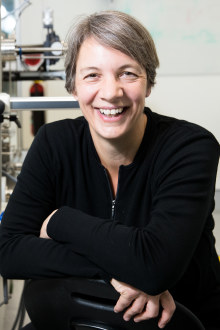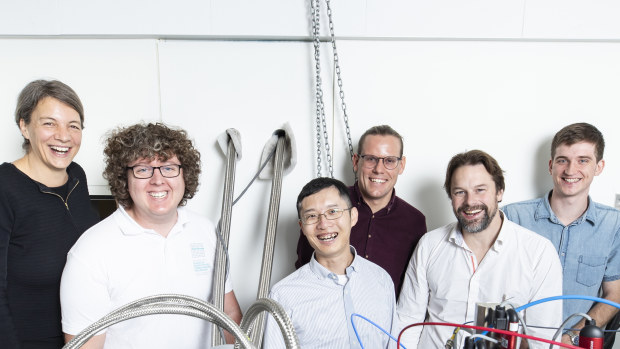UNSW lab in quantum leap breakthrough
Australian physicists have achieved a breakthrough in quantum computing, bringing the world closer to technology that could revolutionise industries such as finance and medicine by enabling significantly faster computation.

Professor Michelle Simmons led her team at UNSW to the breakthrough. Janie Barrett
Their achievement is getting two atom-based quantum bits (qubits) in silicon to swap information without loss. This was partly done by reducing the distance between the units to 13 nanometres, a feat long considered impossible.
The University of NSW laboratory had shown in March last year that the qubits could "talk" at an elementary level by showing a correlation in their electron spins. But this is the first time the scientists have entangled two qubits and managed to exchange information between them.
Three or four entangled qubits would be capable of performing a simple algorithm, the UNSW team said.
It aims to create a 10-qubit integrated circuit, which would be capable of multiple functions, within three or four years.
Team leader Michelle Simmons, who was last year's Australian of the Year, said the achievement was the culmination of 20 years of work that would propel the scientists towards their goal of creating a "scalable quantum computer in silicon".
"There's nothing stopping us other than time and money," she said.
The UNSW physicists are not the first to entangle qubits. Intel unveiled a 49-qubit test chip named Tangle Lake in January last year; Google followed suit two months later with a 72-qubit processor called Bristlestone.
But Professor Simmons said her lab's approach of using atom-based qubits in silicon eventually would outperform its rivals.

From left, Michelle Simmons (team leader and Centre Director), Dr Sam Gorman (joint first author), Dr Yu He (joint first author), Mr Ludwik Krank, Dr Joris Keizer and Mr Daniel Keith.
Google, Intel, and IBM use superconducting circuits as the basis of their processors; another popular method uses "trapped ions", charged atomic particles that have been suspended in electromagnetic fields.
Professor Simmons said silicon-based qubits were preferable because they held the longest coherence time and highest fidelity, which respectively measure how long qubits hold their quantum state and how accurately they exchange information.
Intel has said it is also researching spin-based qubits to address "some of the challenges that are inherent" to its own processors.
The two-qubit gate at UNSW completed an operation in 0.8 nanoseconds, which is about 200 times faster than other spin-based counterparts. But Professor Simmons said she would not rush in her efforts to build this out into an integrated circuit.
"If you scale too quickly, it is hard to focus on what's not working ... We want to focus on quality at every stage," she said.
There are two common metrics for evaluating quantum computing success. The first is building a machine that outperforms classical computers, and thus achieves "supremacy". The other is developing a processor with a viable commercial application. The former needs about 50 qubits, the latter requires fewer.
Quantum computers theoretically could revolutionise any industry that relies on heavy computation and data processing.
This is because qubits, unlike classical data bits, represent 0 and 1 at the same time, allowing them to make calculations at a much faster speed.
Commonwealth Bank invested $14 million in the UNSW lab in August 2017, citing the technology's potential to enhance "real-time analysis of [customer] patterns and interactions".
But in the short term, the use of nascent quantum capabilities would have a more inward-looking focus. Professor Simmons said the results of previous experiments would inform where and how the lab added qubits to create a circuit.
"We're using the quantum computer to help build itself," she said.
Subscribe to gift this article
Gift 5 articles to anyone you choose each month when you subscribe.
Subscribe nowAlready a subscriber?
Introducing your Newsfeed
Follow the topics, people and companies that matter to you.
Find out moreRead More
Latest In Technology
Fetching latest articles